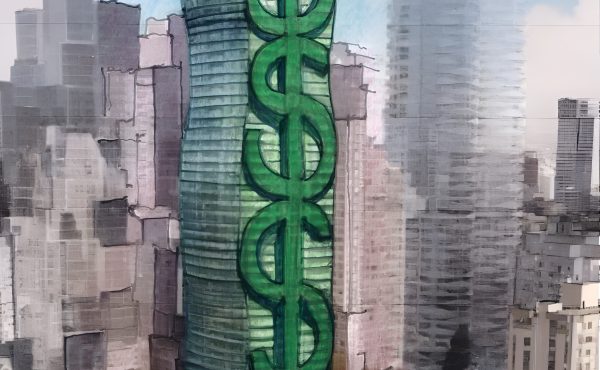

Author: Alain de Botton (Pantheon, 2006)
I recently found myself speechless after a follower of my writing asked me why I’ve never addressed beauty in the urban environment. Given the breadth of issues I tend to cover through my urban cartography and articles, he seemed somewhat confused that the issue of beauty had never even been mentioned once. It is a very important issue, after all. Especially given how the term is used constantly to describe all aspects of the urban environment – from buildings to products.
Yet, despite its significance – and one would be hard pressed to honestly admit that they would like to live in anything but a beautiful place – sincere discussions about how and why to create beauty in buildings and the urban environment has fallen by the wayside – relegated to the fringes of the professional design circles. Why is this so? Despite the current tendency to value all aesthetic choices as equal, is there merit in discussing aspects of beauty and how to achieve it in the built world?
Alain de Botton certainly thinks so and courageously breaks the silence in his well-received book The Architecture of Happiness. Having heard good thing about the book when it was originally released, I recently read it after randomly coming across a copy on a music store table looking awkwardly out of place.
Inspired by Stendahl‘s statement “Beauty is nothing other than the promised of happiness” written in his 1822 piece De L’Amour (On Love), de Botton critically analyzes the built world and acutely describes how human values, desires and ideals are manifested in architecture. Towards this end, the book is divided into six chapters – The Significance of Architecture, In What Style Shall We Build, Talking Buildings, Ideals of Home, The Virtues of Buildings, and The Promise of a Field – each of which elaborates on the issues discussed in the chapters prior. Breaking up each chapter are a series of numbered, bite-sized subsections and as well as a handful of images that speaks to the theme(s) being discussed.
The book opens with the argument that the visual and spatial world have an impact on our psychological well-being. For example, that we can be emotionally affected by the colour of a wall, or the texture of old wooden floors. By extension, he describes the significance of beautiful architecture – despite it many limitations – on our sense of happiness, and in doing so, suggests that the question of what a beautiful building might look like is critical.
The second chapter – In What Style Shall We Build – takes a succinct historical look at the changing definition of beauty in the architectural field over time. From the temples of ancient Greece to contemporary era, he develops the idea that beyond solely visual appeal, values are embedded within buildings and that this recognition is pivotal to our understanding the built environment.
Talking Buildings fleshes out the idea that values are communicated through architecture and how materials can express something through their form and arrangement. Accordingly, de Botton illustrates how even abstraction forms “speak” to us, citing several examples from everyday furniture, appliances and fonts, to sculpture and architecture. He ends the chapter by stating that architectural beauty is tied the values a building expresses – values intrinsically linked to what makes us happy.
The fourth chapter – Ideals of Home – delves into the relationship between architecture and memory. More specifically, that beautiful architecture serves to embody and remind us of the qualities that that we do not possess, but that we work towards….the ideal qualities we wish to attain. These claims are explained with reference to a number of past and modern architectural projects such as Oscar Niemeyer’s Brasilia and the Casa Malaparte in Capri Italy. Furthermore, de Botton discusses the relationship between changing ideals and aesthetics preferences. This is based on the writings of historian Wilhelm Worringer, who attempted to explain the psychological shifts in artistic preferences over different eras.
Working from the argument of the previous chapters, The Virtues of Buildings attempts to describe the in more specific terms the qualities beautiful buildings possess—that is, order, balance, elegance, coherence, and self-knowledge. A larger subsection is devoted to explaining each of the latter using a wide range of architectural examples, past and present.
The Promise of a Field addresses the common argument that puts the original wildness of a given site against the built environment – that leaving a site to nature is intrinsically better than transforming it through architecture and building. To this de Botton states that such a conflict need not be the case and that we owe it to the virgin lands we replace to construct beautiful buildings and environments that embody the ideal values we aspire to. A fitting end to the book.
From beginning to end, the Architecture of Happiness certainly lived up to all its acclaim and I found myself captivated by the 270 page book from the moment I opened it. Although one strong criticism of the book was that the language came across as pompous at times—an argument that I can somewhat sympathize with—I found the book quite accessible, as a whole. Furthermore, the significance of the themes introduced in the book surrounding beauty in the built world easily override the concerns of those negative critics.
The Architecture of Happiness is an important book, coming at a time when we need to critically and publicly discuss the subject of beauty in the built world. It is a must-read for anybody interested and involved in shaping the the man-made environment and how we, in turn, are shaped by it.
***
Erick Villagomez is the Editor-in-chief at Spacing Vancouver. He is also an educator, independent researcher and designer with personal and professional interests in the urban landscapes. His private practice – Metis Design|Build – is an innovative practice dedicated to a collaborative and ecologically responsible approach to the design and construction of places. You can also see some of his drawing and digital painting adventures at Visual Thoughts.



